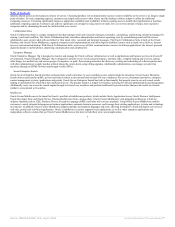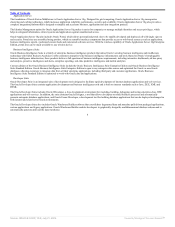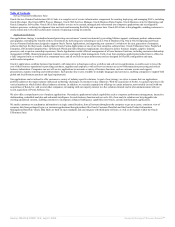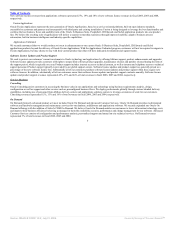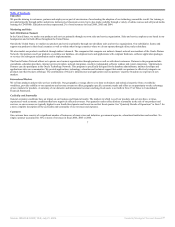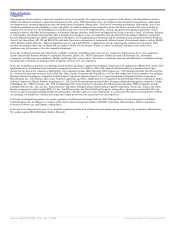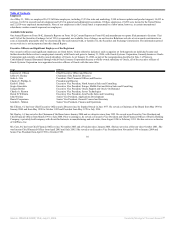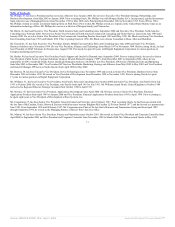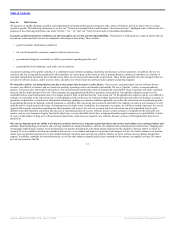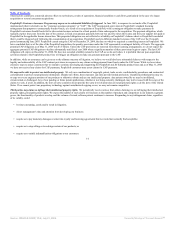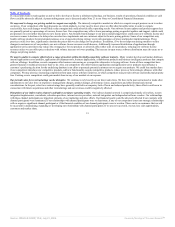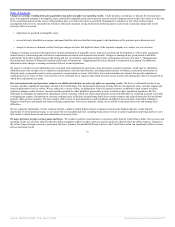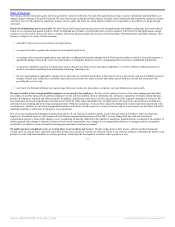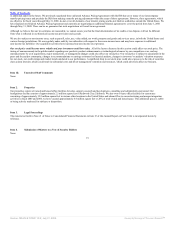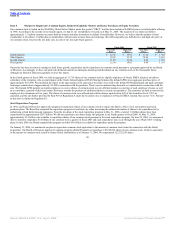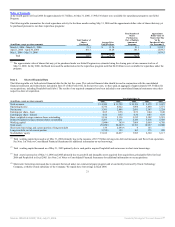Oracle 2005 Annual Report Download - page 16
Download and view the complete annual report
Please find page 16 of the 2005 Oracle annual report below. You can navigate through the pages in the report by either clicking on the pages listed below, or by using the keyword search tool below to find specific information within the annual report.
Table of Contents
standards on which we choose to develop new products will allow us to compete effectively for business opportunities in emerging areas.
We are developing a next generation applications platform that is planned to combine the best features, flows and usability traits of the Oracle, PeopleSoft, JD
Edwards and Siebel applications. We have also acquired several other application product lines, which we will need to continue to provide long-term support for
as well as ensure that the key capabilities of these product lines moves into the next generation platform. If we do not develop and release these products within
the anticipated time frames, if there is a delay in market acceptance of the product line, or if we do not timely optimize complementary product lines, our
applications business may be adversely affected.
Acquisitions present many risks, and we may not realize the financial and strategic goals that were contemplated at the time of any transaction. An active
acquisition program is an important element of our corporate strategy. We expect to continue to acquire companies, products, services and technologies. In the
last two years, we have paid an aggregate of $19.5 billion for acquisitions. Risks we may encounter in acquisitions include:
• the acquisition may not further our business strategy, or we may pay more than it is worth;
• we may not realize the anticipated increase in our revenues if a larger than predicted number of customers decline to renew software license updates and
product support, if we are unable to sell the acquired products to our customer base or if acquired contract models do not allow us to recognize revenues on
a timely basis;
• we may have difficulty incorporating the acquired technologies or products with our existing product lines and maintaining uniform standards, controls,
procedures and policies;
• we may have to delay or not proceed with a substantial acquisition if we cannot obtain the necessary funding to complete the acquisition in a timely
manner;
• we may significantly increase our interest expense, leverage and debt service requirements if we incur additional debt to pay for an acquisition;
• we may have higher than anticipated costs in continuing support and development of acquired products;
• we may have multiple and overlapping product lines that are offered, priced and supported differently, which could cause customer confusion and delays;
• our relationship with current and new employees, customers and distributors could be impaired;
• we may assume pre-existing contractual relationships which we would not have entered into and exiting or modifying such relationships may be costly to
us and disruptive to customers;
• our due diligence process may fail to identify technical problems, such as issues with the company’s product quality or product architecture or unlicensed
use of technology, including, for example, improperly incorporated open source code;
• we may have legal and tax exposures or lose anticipated tax benefits as a result of unforeseen difficulties in our legal entity merger integration activities;
• we may face contingencies related to product liability, intellectual property, financial disclosures and accounting practices or internal controls;
• the acquisition may result in litigation from terminated employees or third parties;
• our ongoing business may be disrupted and our management’s attention may be diverted by transition or integration issues;
• we may be unable to obtain timely approvals from governmental authorities under competition and antitrust laws and from worker councils under
applicable employment laws; and
• to the extent that we issue a significant amount of equity securities in connection with future acquisitions, existing stockholders may be diluted and
earnings per share may decrease.
13
Source: ORACLE CORP, 10-K, July 21, 2006 Powered by Morningstar® Document Research℠


